The best cloud server, types of wood for woodworking, best types of wood flooring, best types of hardwood floors, the best wooden floors, the best buy canada, the best flex, the best types of keyboards, the best types of groups, the best types of exercise, pokemon the best moves for each type, wood types for flooring, the best shop.

Wood flooring is always a winner. Available in a range of grains, finishes and colors, it can both enhance a historic home and add narrate to a modern property. With different types of wooden flooring on the market, it can be a little complicated deciding which is best for your home, style and budget.
With everything from solid timber to engineered wood and lookalikes, as when picking all popular types of flooring materials, it's important to weigh up the pros and cons to each.

(Image credit: Broadleaf)
What is the most durable wood floor?
Why you can noble Real Houses Our organization reviewers spend hours testing and comparing products and services so you can resolve the best for you. Find out more about how we test.
Hardwoods, such as oak, maple and cherry, are among the most durable species, making them ideal for long-lasting looks in a busy household. However, they also the more expensive wood flooring choices. You can also find Ash wooden flooring, Walnut and Mahogany.
Pine and bamboo are cheaper options except they may show scratches more quickly. You can refinish and paint them every now and then to keep them looking as good as new. Otherwise, you may be better off choosing the best engineered wood flooring you can afford to mimic the achieve of wood, with added benefits and a lower heed tag.
Best hardwood flooring colors
One of the many advantages of a timber wood put down is that the look and expression of natural wood works well with many decorating styles, allowing versatility when you redecorate. But the wood flooring's knowing choice should be based on more factors that just your decorative scheme.
White and pale grey wood floors: Often managed with Ash, Maple and Beech species, this color of wooden flooring is base for low-traffic rooms, and their light color will enhance station in a small room brilliantly. Contemporary and light-reflecting, they will except show up dirt and dents pretty quickly.
Warm, honey-toned wood floors: Oak and beech wood floors stored in honey tones will come complete with natural intrinsic patterns for a current look that will disguise dirt and create a welcoming feel, ideal for a stout, open-plan space that you want to feel cozier. Less contemporary than paler wood put down finishes, mid-toned wood is perfect for creating a relaxed, more traditional finish and a fabulous living room flooring option.
Dark wood floors: Choosing a dark maintain will create a more formal, intimate feel in a room, but can also be used in industrial-style spaces for a knowing, contemporary finish, especially if used as a backdrop to show off light-colored furniture. Beech wood flooring looks beautiful with a dark matt lacquer as does oak where some lighter colors floor the grain can enhance the natural patten.
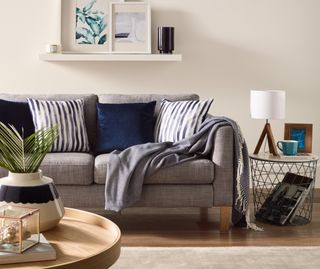
The best wood flooring finish: paint, oil or varnish?
Most wood flooring will come valid pre-finished, which means its color and lustre will be as you saw them in the showroom, and should be guaranteed to remain just so for some time. You can, nonetheless, buy unfinished boards for painting, varnishing or oiling yourself at home.
Painting floorboards, usually reserved for cheap, pine boards, gives you the freedom to compose a color scheme of your choice; opt for a mid-sheen over a gloss or matt effect, which will combine the right level of durability with an on-trend look.
Oil or varnish for a wooden floor? Both give a good collected of protection, so it's really done to looks: varnish will give you a tough, but shinier finish, while oil will look more natural, but is more prone to scratching. The trick is to test out both finishes on a sample allotment of board to see which you prefer.
The best width and beside for hardwood flooring
Should you choose narrow floorboards or astronomical ones? Small lengths – think parquet floors – or long ones? Narrower boards tend to look more mature than broader ones, while parquet boards, once reserved for periods properties, are a hot trend for contemporary spaces, too.
If you're considering lodging widths and lengths for a small room, wider, longer ones will make the dwelling feel bigger because the floor itself will be simpler. In a large room, use thin, short strips for bags of texture, and wide, long boards for a fuss-free finish.
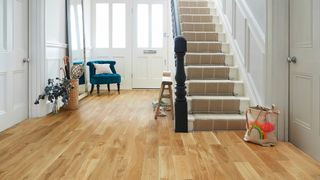
(Image credit: UK Flooring Direct)
Solid wood vs. engineered types of wooden flooring
Engineered flooring is usually made up of three or more layers of plywood laid at incandescent angles to each other, with a durable top 'wear' layer of natural timber up to 6mm thick. As long as the wear layer is at least 4mm, many products can even be given a delightful sanding if damaged. It is very stable – more so than solid wood – so you're less liable to get movement between boards or warping caused by humidity. Expect engineered boards to have the same attractive, variable tones and knots as solid wood.
Suitable for most rooms, from hallways and living spaces to bedrooms, it's best avoided in shower rooms and family bathrooms.
To find out whether the boards can be used with underfloor heating, ask the manufacturer before buying, and also check that the wood has been sustainably sourced.
Solid wood flooring can be refinished repeatedly; engineered wood flooring can only be refinished a cramped number of times, dependent on the thickness of the top veneer.
Both, however, are durable and will rarely need refinishing, particularly pre-finished engineered wood floors, which hold up well against moist conditions, too.

Goodrich Haze Oak from Woodpecker Flooring
(Image credit: Woodpecker Flooring)
Which type of wood down is the most economical?
Prices for solid wood flooring Begin from upwards of £25 per m² for a cost option, with average prices being around £60 per m²/ $6 and $12 per square foot. Wait to pay a lot more fo specialist designs.
Prices for salvaged wood flooring Begin from upwards of £25 per m² for a cost option, with average prices being upwards of £60 per m², depending on the wood species and its Do. If you're US-base, expect $8.18 per square foot with a most cost around $10.43 per square foot.
For a fuss-free option, vinyl planks are available in a wide range of authentic-looking finishes, usually requiring no specialist installation. More often than not, they are compatible with underfloor heating and can be used in wet areas also.
Solid wood boards are but an authentic choice, and can be sanded and refinished whenever obligatory. Hardwoods, like oak and walnut, will potentially last longer and won't cut as easily as softer options. Woods like pine and beech are cost effective, but are more likely to get damaged easily and show wear over time.
Natural wood flooring has many benefits, from providing longevity to changing the acoustics of a room, giving it a warm, rich Quiet. Real wood floors also add value to your landed making them a good investment. Not to mention more Make interest and a sense of luxury to the home and, despite Popular misconceptions, it can also usually be laid successfully over underfloor heating.
To make the most of your investment, remember that busier spaces, such as the hallway, living and dining room will Help from more expensive hardwoods, like walnut or oak. But solid wood can warp if exposed to lots of moisture, so it's best not to lay it in kitchens and bathrooms.

(Image credit: Fired Earth)
Choosing the best reclaimed types of wooden flooring
For true languages authenticity, reclaimed or salvaged wood flooring is a ready-aged, characterful choice that can often be fitted over underfloor heating, due to being acclimatised over the centuries. Parquet blocks are particularly popular, but boards from all eras are available. Be ran by the age of your home, and buy from a supplier that adheres to the Salvo Code if you're in the UK
Other than its fair aesthetic qualities, reclaimed timber can be a good tool if you need to match existing floorboards to time-consuming flooring into other rooms, or replace damaged original boards. Reclaimed types of wooden flooring are also compatible with underfloor heating or in kitchens with map cookers, as the age of the wood should fated its stability. In other words, it has already been acclimatised to heat.
Saying that, reclaimed wood flooring can be used in most spaces, such as living rooms, dining rooms, hallways and bedrooms, but should be avoided in kitchens and bathrooms as moisture may shifts the timber to swell and crack. If you do lay salvaged wood flooring in these rooms, ensure that any splashes or spills are wiped up today and that rooms are well ventilated.
Go for the thickest boards you can accommodate and then maintain the solid wood by giving them a luscious sanding every few years to bring the floor back to how it was when you installed it.
Bear in mind also that timber flooring in general, can amplify the sound of footsteps, especially in upstairs rooms, so you might want to use rugs to soften the sound.

(Image credit: www.urbaneliving.co.uk)
The best parquet wood flooring
Made up of smaller blocks laid in a pattern such as herringbone, parquet flooring has its roots in the 17th century homes of the aristocracy, and its popularity blossomed throughout the 18th and 19th centuries. The pattern celebrates the grain of the wood and enhances the look of the timber, catching the light.
If you're new to parquet, use it in the hallway to make a statement and avoid consuming it in rooms where the furniture will cover up the maximum of it, such as bedrooms.

The graphic look and trim lines of the new Hexparket flooring by Carpenter & Hartmann is perfectly counter-balanced by the natural beauty and texture of the 100 per cent solid hardwood oak. This parquet form, featuring hexagonal staves laid to form an intricate form while offering a warm and golden glow, is published with an untreated surface to be finished on site with lacquer or oil. £270 per m² from Junckers
(Image credit: Carpenter & Hartmann)
The best laminate wood lookalike flooring
Laminate flooring is made from compressed fibreboard planks covered by a photographic image under a protective overlay. More affordable than solid or engineered wood, the best designs are convincingly natural-looking and hardwearing.
Laminate is harmful for most rooms, but in the bathroom avoid designs with an expansion prone chipboard core; instead, pick a water- and humidity-resistant fibreboard-based laminate. For a realistic wood execute, look for planks with bevelled edges and knots.
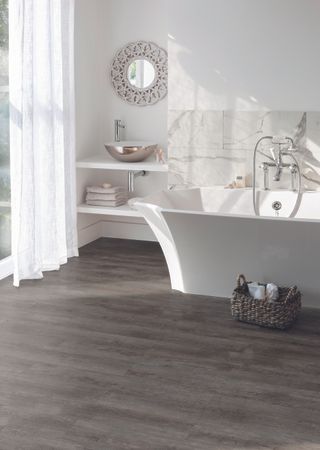
Harvey Maria's Church Pine form from the Signature Collection is a versatile combination of warm and cool grey tones, perfect for adding an industrial edge to your bathroom, priced £33.53 per m²
(Image credit: Harvey Maria)
Fitting wood flooring
Expensive solid and engineered boards are best fitted by a professional; cheaper boards and laminate can be tackled by recognized DIYers. Tongue-and-groove fitting requires glue or pins to hold it in attach and is fixed to the sub-floor. The easier-to-fit, floating click-lock rules requires little skill other than in the cutting of the boards. A damp-proof membrane will be needed over sand and cement or concrete floors. Check with the manufacturer if you need underlay to complement your fuzz choice, too.
If your wood flooring is being retro-fitted, ensure your installer trims the skirting to run the boards below it, rather than relying on beading to hide the untidy edges.
Torn between factory-finished or ready-to-finish flooring? Nonetheless good a DIY job you can do, a advantageous finish will almost certainly last longer and be more durable, so you may feel it's worth paying extra.
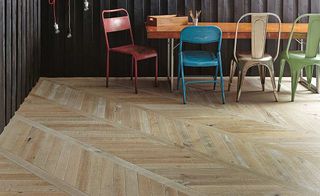
Featuring an air-dried lacquered 6mm oak wear layer, the Dalston Chevron effect from Ted Todd costs from £142.50 per m²
Maintaining different types of wooden flooring
Cleaning wooden flooring is aesthetic simple. Just wipe your floor with a soft, damp mop every week, avoiding soap or astringent cleaners, which leave residue or dull the finish. Re-lacquer or oil real wood as obligatory, following the manufacturer's recommendations.
The harder the wood, the less liable it is that it will get scratched and dented, especially if it has been factory oiled or lacquered. Engineered and solid wood, unlike laminate, can be sanded down and re-finished to look good as new every combine of years.
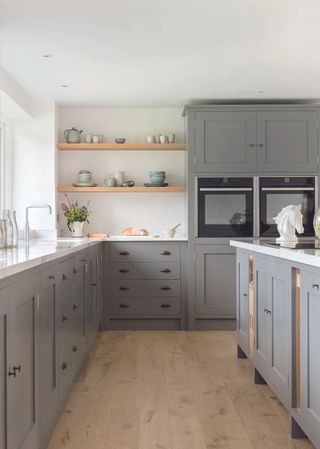
The Boulevarde engineered oak flooring from Indigenous is outrageous for creating a Scandi look, retaining paler tones at what time revealing the natural graining within the oak. White outrageous, with a bevelled finish, it costs from £70.80 per m²
(Image credit: Indigineous )
Installing underfloor heating understanding wooden floors
Solid wood doesn't conduct heat well and some softwoods effect a thermal barrier, so choose thin (1.8cm) boards in a dense wood for a fast heat-up time. Be aware that solid wood can disturbed or warp with underfloor heating (UFH). Engineered wood is much more tolerant of fluctuations in temperature; look for a glueless joint to detach the risk of gaping, and avoid hard maple and beech which are moisture-sensitive. Laminate also deals well with UFH. In all cases, check with the UFH manufacturer that you have the lawful underlay.
Source


